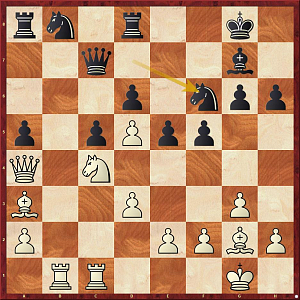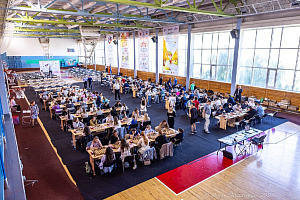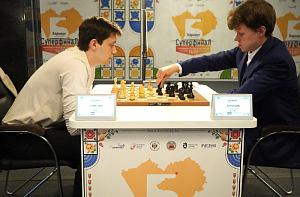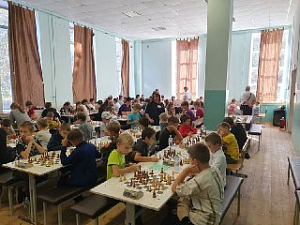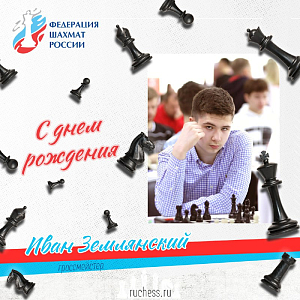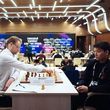Ups and Downs of a Chess Game
Dmitry Kryakvin reviews rounds 4 and 5 of the Russian Superfinal in Novosibirsk.
Playing chess is an arduous toil in general, while playing against heavyweights is a sort of hard labor the existence of which an ordinary player has never even dreamt of. One might feel extremely self-confident when, having only some vague ideas about the whole process, they can still point fingers at others and say, “He-he-he! As for me, it took me only a couple of seconds to pinpoint the right move. As for ChessBomb, they needed so much more time to arrive at the same conclusion!“ And then, reclining relaxedly on an arm chair and putting on a clever face, they go on criticizing grandmasters’ performance much like certain football fans would always know better what to do in the football boots of the “Rostov” fullbacks when it comes to tackling Antoine Griezmann of a ball or tipping Igor Akinfeev about top-notch goalkeeping schemes when playing in the Champions League.On the other hand, with the closeup rounds being not on the horizon in Novosibirsk yet, certain chess heroes’ fans have already done away with all their stocks of Valerian pills and go all out on some stronger stuff already. Indeed, these two rounds have been anything but trivial. Dear participants of the Super Final, especially of the women’s section, spare yourself and us, ordinary fans! Other than those notorious short draws, which the men’s tournaments are known to suffer from time to time, we mean those shocking events that occurred in abundance at this section of the race.
Therefore, let’s first have a closer look at the fragments, which can be qualified as ups and downs of an athletic struggle, whereas for certain beautiful ladies they turned into genuine tragedies...
A patchwork of painful reminiscences
Bodnaruk (2463) – Galliamova (2450)
Round 4
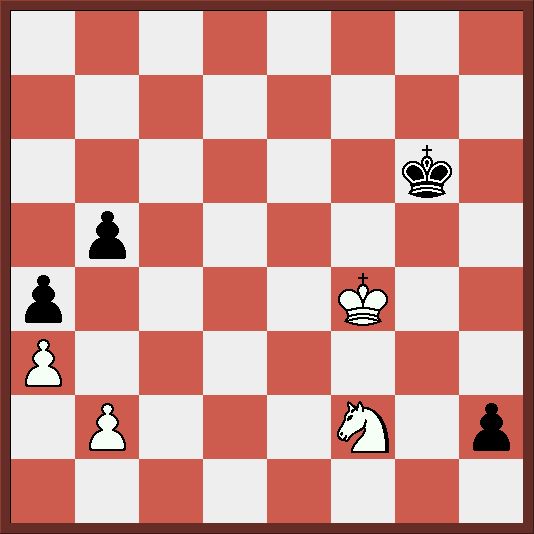
Bodnaruk has been on the roll for the entire game to gradually arrive at a winning position, but when converting her advantage she committed an error, and now the h-pawn, which knights have so much dislike of, safeguards Black from the worst. A draw can be achieved not only via mentioned by all commentators 77...Kf7! 78.Kg3 (there is no running away with the king - 78.Ke5 Kg6) 78...Ke6 79.Kxh2 Kd5 80.Kg3 Kc4 81.Kf3 b4 82.axb4 Kxb4 83.Ke3 a3 and the last pawns quit the board, but also via a provocative 77...Kg7!?, something in the best fighting style of the famous Russian boxer Roy Jones Jr. White is one tempo behind: 78.Kg3 Kf7 79.Kxh2 Ke6 80.Nd3 Kd5 81.Nc1 Kc4 82.Kg2 b4 83.axb4 Kxb4 84.Kf2 a3 85.b3 a2.
Alas, having instinctively covered the e5-square, Alisa Mikhailovna gave her opponent free rein to get rid of the last Black’s trump with the knight.
77… Kf6? 78.Ng4+ Ke6 79.Nxh2 Kd5 80.Nf3
Black’s sovereign eviction via 80.Ke3 Kc4 (80...b4 81.Kd3) 81.Nf3 b4 (81...Kb3 82.Nd4+) 82.Nd2+ would be a good technical display, but Bodnaruk calculated everything accurately, her being fully entitled to choose to her liking.
80...b4 81.axb4 Kc4 82.Ke3 Kxb4 83.Nd4! Kc4
The point is that 83...a3 fails to 84.Nc2+ Kb3 85.bxa3, neither does “shouldering” come to Black’s rescue.
84.Ke4 Kc5 85.Kd3 Kb4 86.Kc2 a3
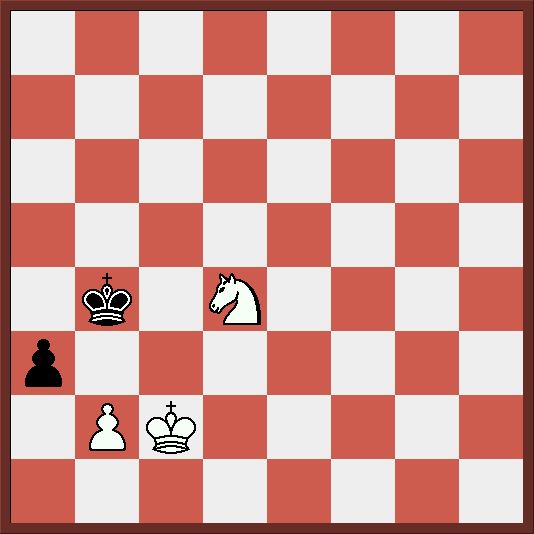
87.b3 a2 88.Kb2 a1Q+ 89.Kxa1 Kc3 90.Ka2 Kxd4 91.Ka3 Kc5 92.Ka4
Despite Black’s winning back a piece, her king fails to take up the saving opposition and the rest of the game is meaningless for that matter.
92…Kc6 93.Ka5 Kb7 94.Kb5 Kc7 95.Ka6 Kb8 96.b4 Kc7 97.b5 Kb8 98.Kb6 Black resigns.
This is a bitter defeat, although White’s win looks more logic to me than a draw. However, this complex endgame’s fragment proved only a prelude to what was to happen the following day.
Galliamova (2450) – Pustovoitova (2386)
Round 5
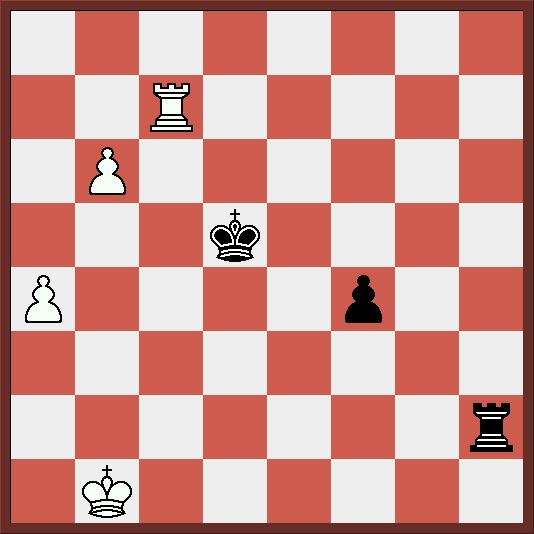
Being outplayed by her mighty opponent, Dasha then followed it by putting up a stubborn defense, arriving at an opportunity to make a draw: 50...f3! 51.b7 Rh8 52.a5 (insufficient is 52.Rf7 Kc6 or 52.Rc8 f2) 52...f2 53.Rf7 Kc6 54.a6 Kb6, doing away with White’s passers.
This impulsive king retreat of Pustovoitova’s is a losing move, which eventually led to an incredible victory.
50…Kd6? 51.Rc4! Kd7
Now the white passer is about to queen with a check in the line 51...f3 52.b7 Rh8 53.Rc8, and it seems as if the game was over since the b7-pawn’s fellow rushes forward to support her.
52.b7 Rh8 53.a5 f3 54.a6 f2
A simple 55.Rf4 Kc7 56.Rxf2 Kb6 57.Rf6+ Ka7 58.Rc6 Kb8 59.Kb2, followed by the white king ascending to the fifth rank and delivering an effective “Gordievsky’s trick” Rc8+! and Кb6, would be winning here. If he wants to, White can dispense with niceties and win simply because the black rook is bound to keep a constant eye on the c8-square.
At this point the commentator Sergey Rublevsky shrugged his shoulders helplessly, “I can not believe it... It seems as though the moves were incorrectly displayed due to a broadcasting error!”
55.a7?? f1Q+ - Queen! White stopped the clock immediately.
This is nothing short of a nightmare, and we cannot but hope that one of the most merited athletes in the history of the Russian women’s chess will once again show her cast-iron will by pulling herself together for the final rounds.
Ovod (2362) – Ubiennykh (2346)
Round 4
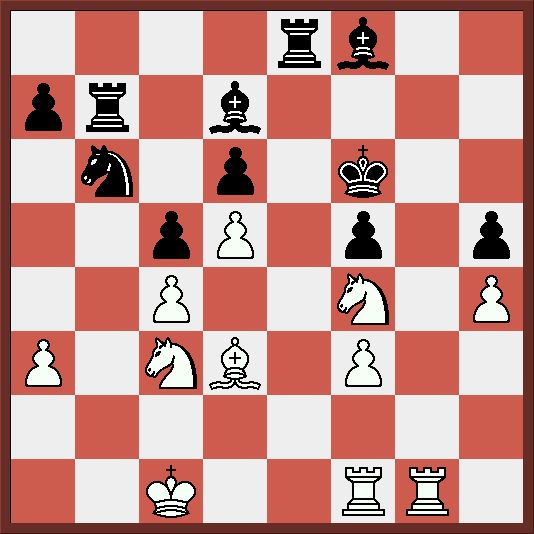
In the upcoming complex struggle Black is no worse, which is evidenced by the following lines: 31...Kf7 32.Nxh5 Bh6+ 33.f4 Re3 34.Rg3 Rxd3 35.Rxd3 Kg6 36.Ng3 Nxc4 or 34.Kd2 Rh3 35.Rh1 Rxh1 36.Rxh1 Kg6 37.Rg1+ Kxh5 38.Be2+ Kxh4 39.Rh1+ Kg3 40.Rxh6 Kxf4 41.Rxd6 Ke5.
However, Ubiennykh decided against sitting back and fearlessly plunged her king towards d4 - straight into the enemy’s lair, but her bold decision backfired as a hasty one as the white pieces got together to weave a mating net around their unexpected guest!
31…Ke5? 32.Nce2 Bh6 33.Rg5!!
This is a crusher that lands the lost traveler cut off from the way of retreat. As the rook cannot be captured, Black’s only hope is her counterplay along the b-file.
33…Reb8
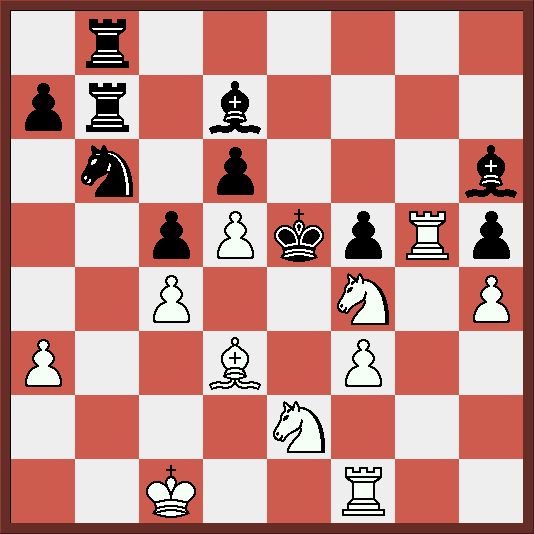
34.Kd2 Nxc4+
The knight says farewell to his life, but worth essaying was 34...Na4!? Thus, 35.Ke3? fails to convert, and after Nb2 36.Nxh5 Bxg5+ 37.hxg5 Nxd3 38.f4+ Nxf4 39.Nexf4 Rb3+ 40.Nd3+ Rxd3+ 41.Kxd3 Rb3+ Black’s winning the game is also not out of the question. It is clear that such a strong tactician as Evgenija Ovod would have been likely to opt for 35.Nxh5 Rb2+ 36.Ke3 Bxg5+ 37.hxg5 Rxe2+ 38.Bxe2 f4+ 39.Nxf4 Kf5 or 35.Re1 Rb2+ 36.Bc2 Rxc2+ 37.Kxc2 Be8. Even though Black is objectively inferior in each arising position, it is a competitive inferiority nonetheless; meanwhile, certain games from the women’s section have proven that nothing should be ruled out.
35.Bxc4 Bb5 36.Kc3 Bxc4 37.Kxc4 Re8 38.Rfg1 Rh7 39.Rxh5 Black resigns.
This defeat caught up in round five when, striving at reversing the unfortunate trend of the tournament, Ekaterina refused from delivering a perpetual check to Bodnaruk on several occasions and went down in the final run. Conversely, the St. Petersburg grandmaster’s false start has given way to the “plus” score and renewed chances for top places.
The “+1” group includes Aleksandra Goryachkina and Daria Charochkina. In the reporting rounds the girls have supplied Mihail Shereshevsky with yet another example for the new edition of his books.
Goryachkina (2460) – Charochkina (2366)
Round 4
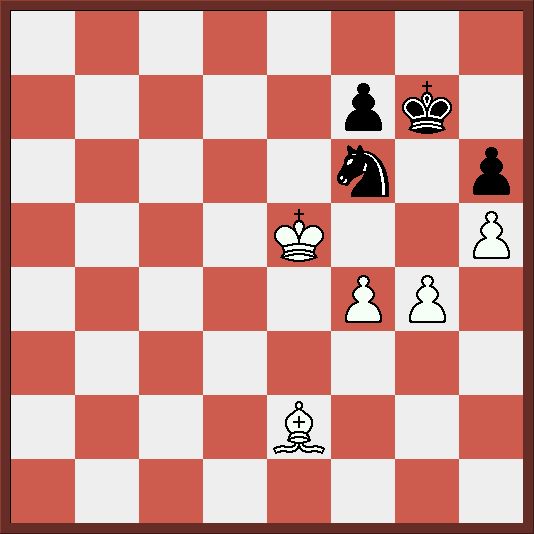
Since a straightforward onslaught will yield no fruits, White’s only hope is to engineer a zugzwang or trap the knight burdened by defensive obligations. It turns out that the defender’s task is not as simple as it might seem at first glance, while 72… Ng8?, in lieu of 72...Nd7+ to knock the king out of his central outpost, could have backfired fatally. The game continued with 73.Bd3? Nf6, and the siege failed to convert White’s advantage into anything substantial. Leading to a victory was a trick that I, frankly speaking, have never come across in the chess literature – White generates a breakthrough by first committing her last pawn to the “wrong” color square.
73.f5! Nf6 (losing is 73...Kf8 74.f6 or 73...f6+ 74.Ke6) 74.g5 Nd7+ (the knight perishes after 74...hxg5 75.h6+) 75.Kd6 Nf8 (75...Nb6 76.f6+ Kf8 77.g6), and the pawns seal the fate of the game: 76.f6+ Kg8 77.g6 fxg6 78.Bc4+ Kh8 79.Ke7. A spectacular victory indeed!
However, in the following round game Caissa more than compensated for Alexandra’s failure to create a study. Following misfires of the starting rounds, her one of the most dangerous opponents won two games in a row and was determined to extend the winning streak when, all of a sudden, she went for her own jugular for no reason whatsoever.
Gunina (2535) – Goryachkina (2460)
Round 5
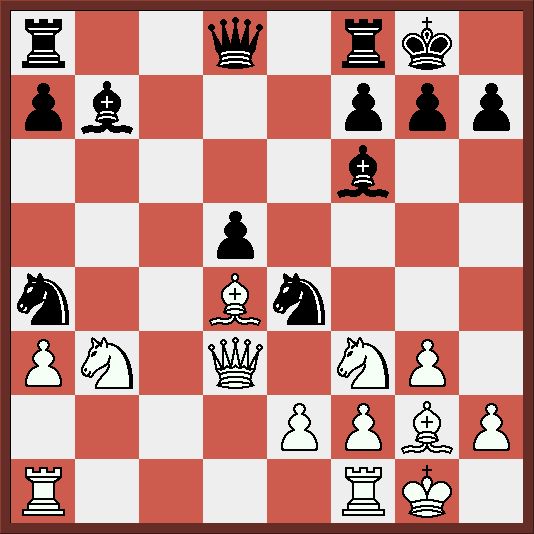
White plays against an isolani, whereas Black’s trump card is her counterplay provided by her knights mounted on strong outposts. After 17.Rfc1 each player would have continued pursuing own plans, with Gunina’s position being slightly superior much to Goryachkina’s dislike. However...
17.Bxf6?! Qxf6 18.Na5?
The blockading move 18.Nfd4 should have been preferred instead.
18...Ba6 19.Qxd5? Nac3, and it is all bad news for White from now on. Aleksandra met 20.Qe5 with the strongest 20…Qb6! (as opposed to this, 20...Nxe2+ 21.Kh1 would not have been equally powerful) – and there is no way for White to guard the e3- and f2-squares.
21.Nb3 Qxb3 22.Nd4 Qc4 23.e3 Rae8 24.Qf4 Qxd4 White resigns.
The game was followed by a press conference during which Goryachkina’s quiet and calm voice revealed simple winning continuations, whereas her companion was sitting there with a puzzled look, seemingly deliberating on her being fortunate that Novosibirsk was at least not a team tournament after all.
Kosteniuk (2537) – Kashlinskaya (2462)
Round 4
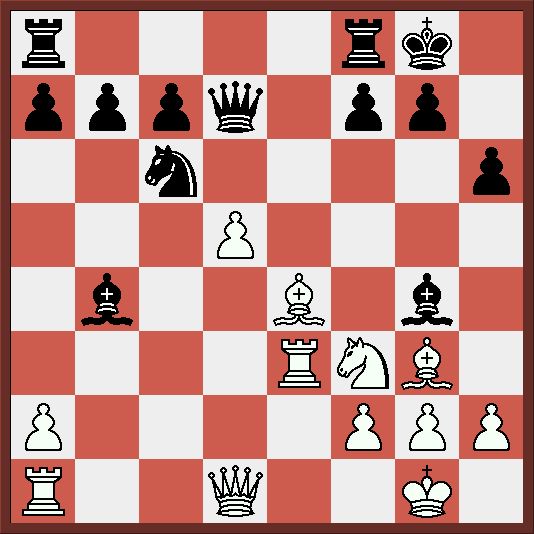
This is yet another game set on perfect opening rails by Alina. A simple 19...Ne7 20.Qb3 Bxf3 21.Rxf3 a5 would have pitted Alexandra against the opinion on the position expressed by master Mnatsakanyan. Quite decent also is 19...Bxf3 20.Rxf3 Ne7 21.Rb1 a5 22.a3 Bd6 23.Rxb7 Rfb8, but the game saw 19...f5?
The broadcasting video stream clearly shows the former world champion being dazzled by an embarrassment of riches, with as many as three continuations leading to the desired goal. 20.Qa4 or 20.Qb1 would have been sufficient, but the toughest is 20.Qb3! Na5 21.Qxb4 fxe4 22.Ne5 Qxd5 23.Nxg4, and White’s being up a piece landed her victorious.
The above fragments are likely to create a biased opinion about the women's chess. Therefore, let’s have a look at two examples where the chess beauty triumphs, and it is difficult to blame the weaker side.
Charochkina (2366) – Ovod (2362)
Round 5
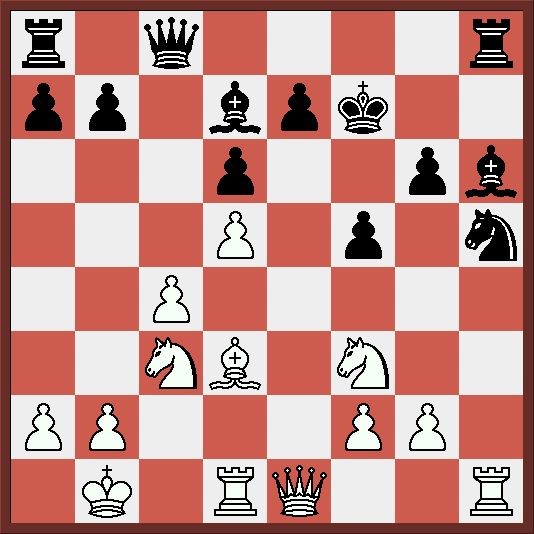
With White’s attack being on the advanced stage, not a few players would have voted for 19.Ne2. Using the weakened e6-square and the principle “make the best of each of your piece” would have completely justified itself... only to render it into a boring game! As for Dasha, she chose to perform in the style of Tal and, despite the scoffs and jeers of a terrible cynic - the computer - we thank her deeply for that choice!
19.g4!?!? fxg4
Losing is 19...Nf4 20.Rxh6! Rxh6 21.Qe3, therefore Ovod grabs everything that comes her way.
20.Bxg6+! Kxg6 21.Qxe7 gxf3 22.Ne4
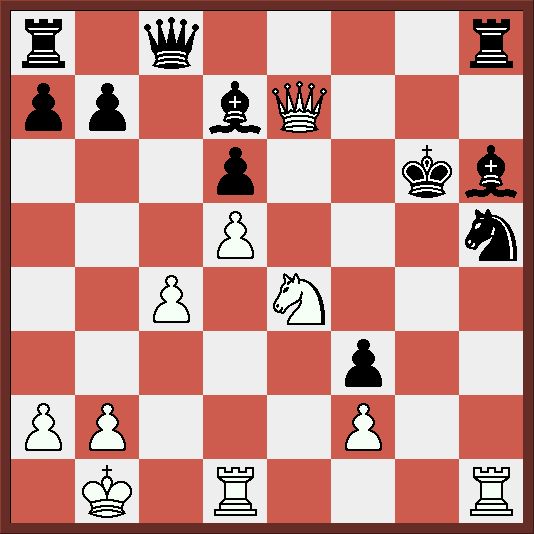
Splendid! White just sacrificed two pieces to crown it with a quite move in accordance with best patterns of chess problems. Uncovering a computer type of defense is far from easy, and Evgenija failed to cope with the task. However, such lines as 22...Bg4 23.Qxd6+ (23.Rdg1 Qf5 24.Rh4 Nf6 does not work for White) 23...Kf7 24.Rxh5! Bxh5 25.Qf6+ Kg8 26.Rg1+ Bg4 27.Nd6 (the gale subsides after 27.Qg6+ Bg7 28.Nf6+ Kf8 29.Rxg4 Qc7) 27...Qd7 28.Rxg4+ Bg7 29.Nf5 Rh1+ 30.Kc2 Qa4+ 31.Kd3 Rd1+ 32.Ke3 Re1+ 33.Kd4 Rd1+ with a draw only serve to demonstrate the degree of this table game’s safety margin!
22…Bh3? 23.Rdg1+ Bg2
The g2 bishop reliably neutralizes the white rook, but fails to defend the h5-knight.
24.Qxd6+ Kf7
24...Kg7 25.Rxh5 offers no defense either.
25.Rxh5 Bg7 26.Ng5+ Kg8 27.Rxh8+ Kxh8 28.Qg6 Kg8
28...Qg8 29.Qh5+ results in a checkmate, but running away fails in equal measures.
29.Qh7+ Kf8 30.Ne6+ Ke7 31.Qxg7+ Kd6 32.c5+ Kxd5 33.Rd1+ Ke4
The alternative line is not difficult to calculate: 33...Kxe6 34.Rd6+ Kf5 35.Rd5+ Ke6 36.Re5#.
34.Rd4+ Kf5 35.Qg5+
35.Rd5+ yields a quicker result.
35...Kxe6 36.Rd6+ Kf7 37.Rf6+ Black resigns.
After the first four rounds board one of the Russian women’s team had a score of 4 points out of 4 possible, but Natalia Pogonina managed to display a technical handling of the complex endgame to revive the tournament intrigue once again.
Pogonina (2484) – Kosteniuk (2537)
Round 5
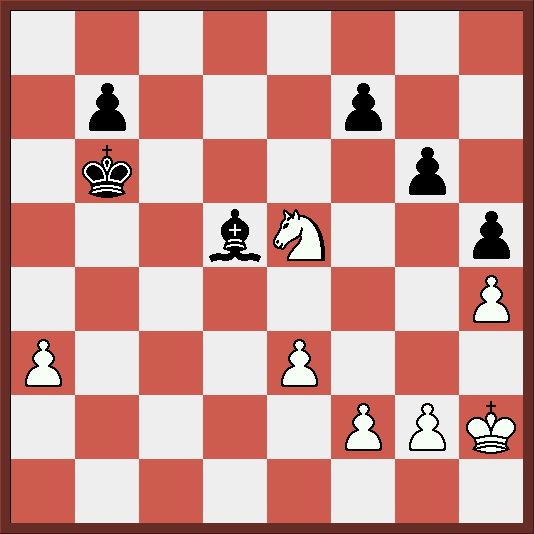
A bishop is a powerful piece in and by itself, coupled with the black king’s eyeballing the a3-pawn with unambiguous intentions. Is it high time that White should run for it? Quite the opposite is true as in her advanced calculations Pogonina accurately evaluated her being in time to engineer a knight barrier against the enemy forces and join the action with the piece bearing a cross on its head.
45.Nd3! Be4 46.Nb2 Kc5 47.f3 Bc2 48.Kg3 f6
Black’s achievements are also questionable after 48...b5 49.Kf2 b4 50.axb4+ Kxb4 51.Ke2 Kc3 52.Nd1+ with a lost pawn ending: 52...Bxd1+ 53.Kxd1 Kd3 54.e4 Ke3 55.Ke1, whereas after 52…Kc4 53.Nf2 the knight is superior to the bishop with the game confined to a single flank. Kosteniuk commits her pawns to dark squares, which is the most tenacious way to try to hold the position.
49.Kf2 g5 50.g3 g4?!
This is playing into the White’s hands since there is no way for Black to capitalize on the e4-square at the moment. Holding out for an opportune moment is one of the most gruelling aspects of chess. Nevertheless, after 50...b5 51.Ke2 Bg6 52.Kd2 Kd5 53.Kc3 g4! 54.fxg4 hxg4 55.Kd2 Ke4 56.Ke2 Bf7 57.Nd1 Bc4+ 58.Kf2 Kd3 White’s winning would be problematic even for the software, let alone for a human player in an over the board game. 59.a4 Kc2 60.axb5 Bxb5 61.Ke1 Kd3 62.e4 Kd4 63.Nf2.
51.fxg4 hxg4 52.Ke2 Bf5
Now the bishop blocks the road of the king, even though after 52...Be4 53.h5 Kd6 White should gradually gain the upper hand as well.
53.h5 Kd5 54.Nd3! Kc4 55.Nf2 Kb3 56.e4 Bh7
As simultaneous guarding of two objects defies bishop’s capabilities, Black has to give up a pawn, thus allowing Pogonina to create the connected passed pawns.
57.Nxg4 Bxe4 58.Nxf6 Bb1 59.g4 Kxa3
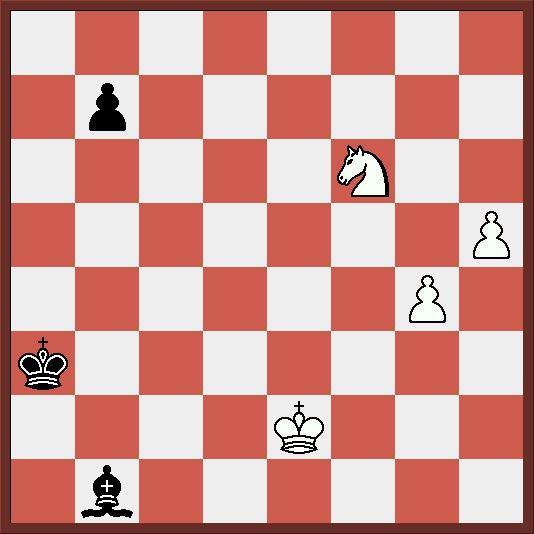
60.g5
This minor error has no bearing on the fate of the game: 60.h6 b5 61.h7 Bxh7 62.Nxh7 b4 63.Nf6 b3 64.Ne4 would be a more straightforward path to victory. Now, by the conventions of the genre, the dry technical ending transposes into pawn races towards the queening squares.
60...b5 61.g6 b4 62.g7 Ba2! 63.h6 Bc4+
The former world champion has found the only practical chance, which, much to her grief, leads to the queens traded off at the end of the line, thus denying Black the saving opportunity.
64.Kd2 b3 65.h7 b2 66.h8 Qb1Q 67.Qa8+ Kb2 68.Qb8+ Ka1
With 68...Bb3 failing to 69.g8Q, White only needs to bring her king closer to help the knight displace the bishop from the short g8-h7 diagonal. This goal is achieved by simple means.
69.Qxb1+ Kxb1 70.Kc3 Bf7 71.Kd4 Kc2 72.Ke5 Kd3 73.Ng4 Bg8 74.Nh6 Bh7 75.Nf7 Ke3 76.Ng5 Bg8 77.Ne4 Kf3 78.Nf6 Bf7 79.Kf5 Ke3 80.Ng4+ Black resigns.
The situation after round five is rather unsettled: 1. Alexandra Kosteniuk - 4; 2-3. Olga Girya, Natalija Pogonina - 3.5; 4-6. Aleksandra Goryachkina, Daria Charochkina, Anastasia Bodnaruk - 3; 7. Evgenija Ovod - 2.5; 8-9. Valentina Gunina, Daria Pustovoitova - 2; 10. Alisa Galliamova - 1.5; 11-12. Ekaterina Ubiennykh and Alina Kashlinskaya with 1 point.
It goes without saying that a lot, if not everything, will be decided in a face-to-face battle between Kosteniuk and Girya that is in store for us in the next round. The players sharing 4-6 places keep their hopes up as well. I will refrain from saying anything about Gunina because it has been known for many years that Valentina can only be believed in.
An Endgame Manual
The men’s section has witnessed a number of milestone events. Dmitry Jakovenko, having sustained the “shock therapy” in the game against Goganov, instantly pulled himself together to defeat Inarkiev and Bocharov and join the leaders. As for Goganov, he missed the “chance of life” versus Oparin. A step towards defending his title has been made by Evgeny Tomashevsky and, at last, Karjakin’s prophecy about Alexander Grischuk has finally started taking shape as the latter has “woken up” to show his warrior’s ability.
Inarkiev (2732) – Jakovenko (2714)
Round 4
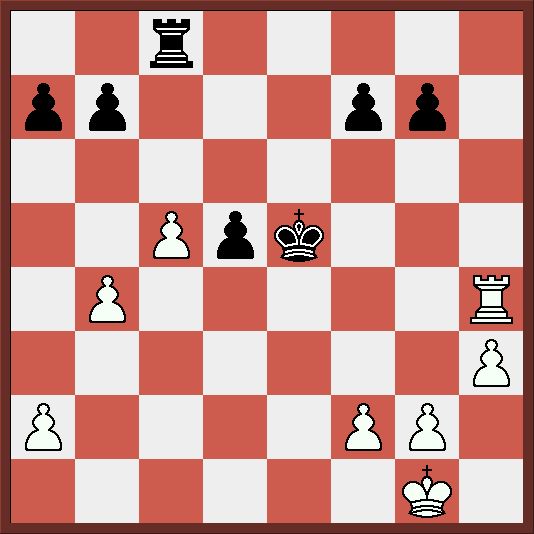
Despite White’s being up a pawn and his forces deployed relatively well, in his advanced calculations Jakovenko evaluated his passed pawn as outweighing all these factors, much like in the classical game of Capablanca.
27…d4 28.Kf1 Kd5 29.Rg4
Ernesto obviously disliked 29.Ke2 Kc4 30.Kd2 because of 30…a5, while 29.Rf4 Re8! 30.Rxf7 d3 would have been similar to what happened in the game.
29...Kc4 30.Rxg7 Kc3 31.Rxf7 Rd8
The pawn is unstoppable since 32.c6 bxc6 33.Rf5 Rd5 34.Rf6 c5 does not work for White.
32.Ke1 Kc2 33.Rf4 Re8+! 34.Kf1 d3
With the white king cut off, Inarkiev is forced to give up his rook, pinning his hopes on the connected passed pawns.
35.Rc4+ Kb2 36.g4 d2 37.Rd4 Kc3 38.Rxd2 Kxd2 39.Kg2 Kc3!
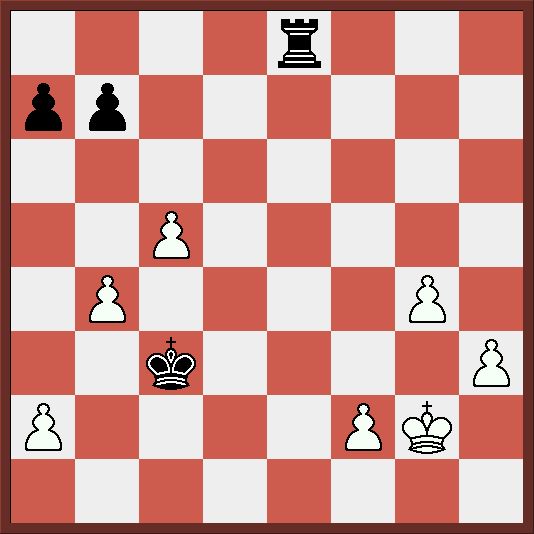
This is a huge disappointment for White. Not only does an athletic black king manage to create a passed pawn on the queenside, but he is also in time to return to the kingside to assist his rook.
40.a3
An important line is 40.b5 Kc4 41.c6 b6!, whereas 40.h4 Kxb4 41.Kg3 Kxc5 42.h5 Kd4 is an easy victory.
40...Kb3 41.h4 Kxa3 42.h5 Kxb4 43.Kg3 a5 White resigns. The technical display by Dmitry Jakovenko with seemingly obvious moves is really impressive!
Just like in the women’s section with Galliamova and Bodnaruk, further fates of our heroes would follow different trajectories - Inarkiev got under Tomashevsky’s wheels, while Jakovenko crushed Bocharov with the white pieces.
Tomashevsky (2724) – Inarkiev (2732)
Round 5
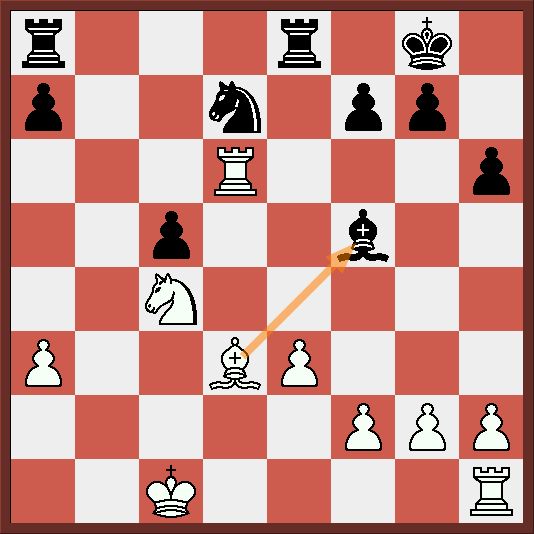
Still fresh in the memory is a graceful save by Inarkiev in a key team matchup of spring between same opponents when “Siberia” was pitted against the Moscow team. This time Tomashevsky managed to take a kind of endgame revenge, but not without assistance from his partner.
19…Bxd3?!
With the light-squared bishops off the board, the c5-pawn weakness is more pronounced and White finds it easier to mobilize his forces. 19...Be6 20.Kd2 Rab8 should have been preferred instead, even though after 21.Rc1 Black has yet a long way to make a draw.
20.Rxd3 Nb6?!
A precise 20...Re4! would have displaced the white rook to gain a crucial tempo: 21.Rc3 Re6 22.Rd1 Nb6 23.Nd6 Rd8 24.Rcd3 Kf8.
21.Nd6 Re5 22.Kc2 Rd5?
Once the second white rook joins the battle, the black pawns are going feel rather uncomfortable. Therefore, Black should have maneuvered his king to other pieces’ aid. The unfortunate trade of rooks by far simplifies the task of the Saratov grandmaster.
23.Rxd5 Nxd5 24.Rb1 Rd8 25.Nc4 f6
Losing material is unavoidable for Black now: 25...Rd7 26.Rb8+ Kh7 27.Rc8.
26.Rb7 Ra8 27.Nd6, and White won the game.
Jakovenko (2714) – Bocharov (2611)
Round 5
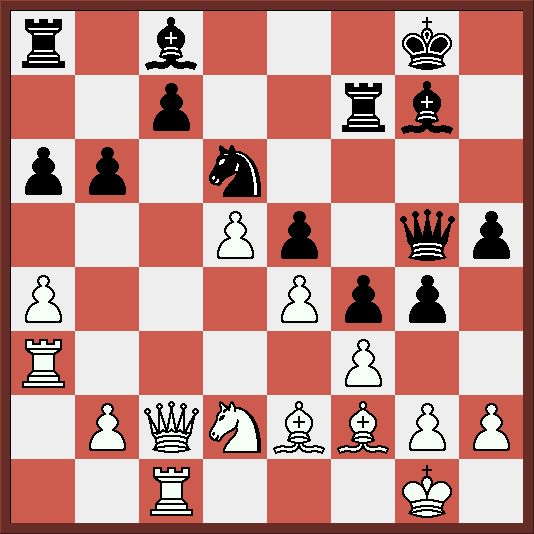
Even if the game opening was handled into the Pirc defense, it was reshaped into a typical KID’s structure. Had it been Teimour Radjabov to play the black pieces, he would have undoubtedly followed up with his trademark maneuver 23...Bf6! 24.Rc3 Bd8 to securely defend the c7-pawn and prepare for further counter measures. However, Bocharov reacted in a typical manner and surrendered the initiative to his opponent.
23…Bf8?! 24.Rc3 g3?
Even though 24...Bb7 is a way to defend the pawn, lack of a powerful bishop in Black’s offensive gives White a free rein in his own attack: 25.b4 (bad is 25.Rxc7? Rxc7 26.Qxc7 Rc8) 25...Rg7 26.Qb2 Rc8 27.Be1, and White should gradually break through the vulnerable queenside of Black’s. Despite 24...Ne8 falling short to 25.d6 or 25.Bxb6, an attempt to deliver a checkmate fails in equal measures.
25.hxg3 fxg3 26.Be3 Qh4 27.Nf1 Ne8 28.d6!
A vital nuance being that 28...Bxd6 fails to 29.Bc4, Black has to allow intervention of the enemy pieces into his camp.
28…Nxd6 29.Rxc7 Be6 30.Rxf7 Bxf7
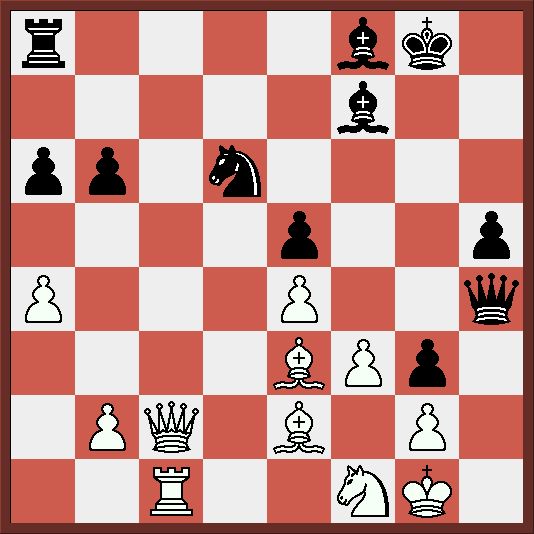
31.Qd2
Tempting is 31.Qc6, but Dmitry is in his element and opts for a simple, reliable, and efficient way. Following the downfall of the g3-pawn the game did not last long.
31...Be7 32.Qe1 Bg5 33.Bxg5 Qxg5 34.Qxg3 Qxg3 35.Nxg3 and White prevailed in a short while.
A historic opportunity to grab the lead in the Superfinal race was missed by Aleksey Goganov. His young optimistic opponent sacrificed a pawn, and the native of St. Petersburg, in the opinion of our colleagues from ChessPro, had decent chances to fight off the onslaught while retaining material advantage.
Oparin (2617) – Goganov (2635)
Round 4
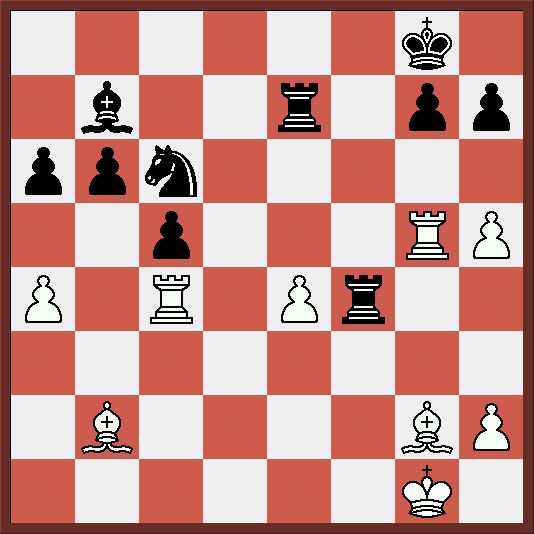
28…Nd8?!
A precise 28...h6! 29.Rg6 Na5 30.Rc1 (or 30.Bc1 Rf6 31.Rxf6 Nxc4) 30...Bxe4 31.Re1 Bxg6 32.Rxe7 Bf7 would have harvested more pawn material. Apparently, Aleksey missed his opponent’s pawn “stab”, got nervous and burned down prior to the time control move.
29.a5 Rd7 30.Rc1 b5?!
Another substantial inaccuracy; why not immediately remove the “root of all evil” with 30...bxa5. Now White has a “spare passer”, which, coupled with a bishop pair, adds up to a serious force.
31.Rgxc5 Bxe4 32.Bh3 Rd3 33.Be5 Rf8 34.Rc7 Rf7 35.Bc8!
The turn has now come for the a6-pawn to be taken into custody.
35…Rd5 36.Rxf7 Kxf7 37.Rc7+ Ke8 38.Bxg7 Rg5+ 39.Kf2
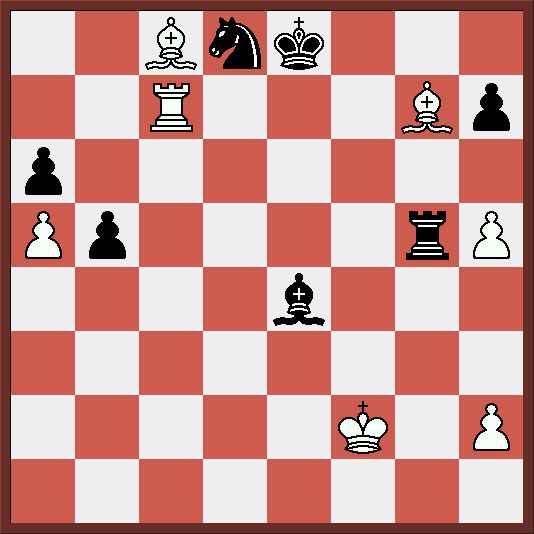
39...Rg2+?
The allowability of 39...Rxh5 does not readily lend itself to calculation when in time trouble. Now 40.Bd7+ does not win a piece - 40…Ke7 41.Bg4+ Kd6 42.Rc8 Rg5 43.Rxd8+ Kc6 44.Bd7+ Kc7 45.Bf6 Rd5, and Oparin would have had to resort to some geometrical tricks to squeeze anything substantial out of this position. This error affords an effortless win to the Superfinal newcomer.
40.Ke3 Bc6 41.Bf6 Rxh2 42.Rxh7 Black resigns.
In round five the decisive spurts were made by the heavyweights. Even if Svidler, being within striking distance of Kokarev, failed to find a cute pawn stab, which promised decent winning chances, Grischuk managed to raise up to the occasion nonetheless.
Grischuk (2752) – Oparin (2617)
Round 5
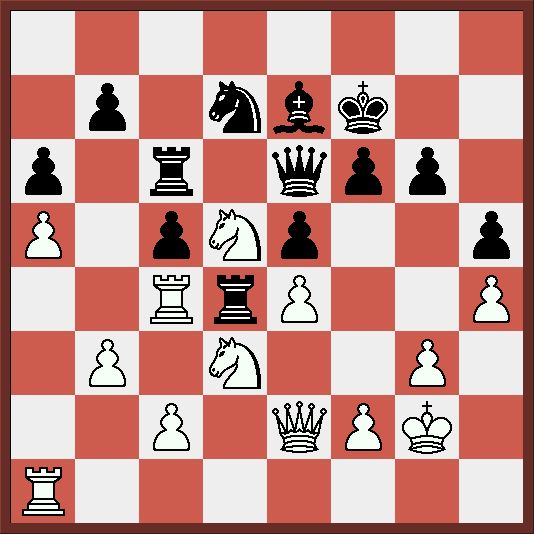
The strict professor gradually drove the student into a corner, but now he should not have cashed in by winning the exchange yet but should have started with 46.Qf3 instead, maintaining domination along the light squares.
46.c3?! Rxd5 47.exd5 Qxd5+ 48.Qf3?!
Or, conversely, Grischuk was right to grab the exchange, but should not have parted with his strongest piece and played 48.f3 for that purpose. In the ending Black makes a series of active moves to find out that he has a decent compensation for the sacrificed material.
48...Qxf3+ 49.Kxf3 f5 50.Ke2 e4 51.Nf4 Ne5 52.Rca4
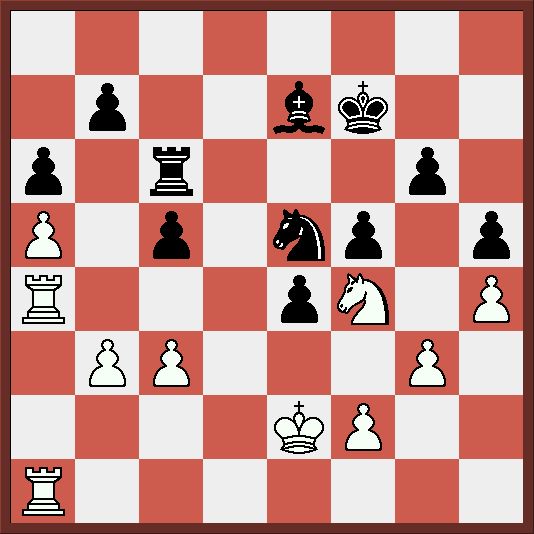
An unclear game would have arisen after 52...g5! 53.hxg5 (53.Nd5 gxh4 54.Nxe7 Kxe7 55.gxh4 Nf3) 53...Bxg5 54.Nh3 (54.Nxh5 Rh6 55.Nf4 Bxf4 56.gxf4 Nd3) 54...Bf6 55.Rh1 Nf3 - how is this knight weaker than a rook? However, in the midst of the struggle Grisha would unexpectedly commit a bad blunder, falling victim to an optical illusion.
52…c4? 53.Rb1! cxb3 54.Rxb3 Nd7?
Further resistance could be maintained by 54...Rc7 55.Nd5 Rd7 56.Nxe7 Rxe7 57.Rb6 Nc6 58.f3, although the rooks have broken free and Black is not to be envied.
55.Rxb7 Nc5 56.Rc4 Black resigns: he does not win back the exchange while having dropped some pawns already.
After five rounds the situation is very similar to that of 2012, when Dmitry Andreikin won a grand round robin tie-break among the players who have scored “+1". Is it another instance of what goes around, comes around?
1-6. Alexander Grischuk, Dmitry Jakovenko, Peter Svidler, Vladimir Fedoseev, Alexander Riazantsev, Evgeny Tomashevsky - 3; 7-9. Grigoriy Oparin, Aleksey Goganov, Dmitry Kokarev - 2.5; 10. Nikita Vitiugov - 2; 11. Dmitry Bocharov - 1.5; 12. Ernesto Inarkiev - 1.
I do want to believe that the winner scores at least 7 points. However, it is not fair to complain taking into account the number of points scored in round five!












